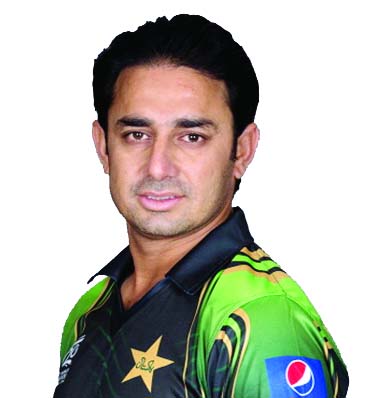
AFP, Karachi :
The ban slapped on star spinner Saeed Ajmal has left Pakistan’s cricket chiefs frantically trying to take action on “chuckers”, including dusting off expensive biomechanical testing kit that had laid unused for years.
Ajmal, who turns 37 next month, was suspended from international cricket on Tuesday after biomechanical analysis found his bowling action, reported during the Galle Test against Sri Lanka last month, to be illegal.
He must now undergo remedial work on his action, and Pakistan Cricket Board (PCB) chairman Shaharyar Khan acknowledged chucking was rife in the domestic game.
“I was informed 25 suspected bowlers had been playing in our domestic cricket and now the number has increased up to 35 — that means every team has at least two suspected bowlers,” said Khan.
Former captain and ex-PCB director of National Cricket Academy (NCA) Aamir Sohail said there were warning signs for Ajmal, who has bowled more balls than any other international bowler in the last three years. “I had warned in February this year that Ajmal will be suspended because his action was deteriorating with age, but no one heeded. I had recommended his action be checked every year,” he told AFP.
Former opening batsman Sohail, who played 47 Tests and 156 ODIs for Pakistan, said there had been a total lack of interest in dealing with bowlers with suspect actions.
“We are ourselves to blame,” Sohail told AFP. “We have a biomechanic lab in NCA which I activated and gave a list of bowlers to test there, but the lab remained ineffective for years.”
The NCA has equipment to test bowlers to check they are not straightening their arm more than the permitted 15 degrees in delivering the ball.
But the $440,000 kit, which includes 18 cameras supporting apparatus and computer software, has gathered dust since it was bought in 2009 as successive PCB chiefs dismissed the need for it.
Cleared of chucking due to a congenital defect of his elbow in 2009, Ajmal came under suspicion again this year when England paceman Stuart Broad and former captain Michael Vaughan queried his action while the Pakistani was taking wickets at will in county cricket.
In June the International Cricket Council’s cricket committee recommended a stricter approach on illegal actions. That snared Sri Lanka’s Sachitra Senanayake and New Zealand’s Kane Williamson-both suspended in July-and then attention turned to Ajmal.
His ban is a huge blow for Pakistan as he has led the team’s attack almost single-handedly across all three formats and was seen as key to their chances in next year’s World Cup in Australia and New Zealand.
Head coach Waqar Younis faces a daunting task in finding a replacement for one of the world’s best bowlers.
The ban comes at a particularly difficult moment, with Pakistan facing a tough series against Australia in the United Arab Emirates next month.
The ban slapped on star spinner Saeed Ajmal has left Pakistan’s cricket chiefs frantically trying to take action on “chuckers”, including dusting off expensive biomechanical testing kit that had laid unused for years.
Ajmal, who turns 37 next month, was suspended from international cricket on Tuesday after biomechanical analysis found his bowling action, reported during the Galle Test against Sri Lanka last month, to be illegal.
He must now undergo remedial work on his action, and Pakistan Cricket Board (PCB) chairman Shaharyar Khan acknowledged chucking was rife in the domestic game.
“I was informed 25 suspected bowlers had been playing in our domestic cricket and now the number has increased up to 35 — that means every team has at least two suspected bowlers,” said Khan.
Former captain and ex-PCB director of National Cricket Academy (NCA) Aamir Sohail said there were warning signs for Ajmal, who has bowled more balls than any other international bowler in the last three years. “I had warned in February this year that Ajmal will be suspended because his action was deteriorating with age, but no one heeded. I had recommended his action be checked every year,” he told AFP.
Former opening batsman Sohail, who played 47 Tests and 156 ODIs for Pakistan, said there had been a total lack of interest in dealing with bowlers with suspect actions.
“We are ourselves to blame,” Sohail told AFP. “We have a biomechanic lab in NCA which I activated and gave a list of bowlers to test there, but the lab remained ineffective for years.”
The NCA has equipment to test bowlers to check they are not straightening their arm more than the permitted 15 degrees in delivering the ball.
But the $440,000 kit, which includes 18 cameras supporting apparatus and computer software, has gathered dust since it was bought in 2009 as successive PCB chiefs dismissed the need for it.
Cleared of chucking due to a congenital defect of his elbow in 2009, Ajmal came under suspicion again this year when England paceman Stuart Broad and former captain Michael Vaughan queried his action while the Pakistani was taking wickets at will in county cricket.
In June the International Cricket Council’s cricket committee recommended a stricter approach on illegal actions. That snared Sri Lanka’s Sachitra Senanayake and New Zealand’s Kane Williamson-both suspended in July-and then attention turned to Ajmal.
His ban is a huge blow for Pakistan as he has led the team’s attack almost single-handedly across all three formats and was seen as key to their chances in next year’s World Cup in Australia and New Zealand.
Head coach Waqar Younis faces a daunting task in finding a replacement for one of the world’s best bowlers.
The ban comes at a particularly difficult moment, with Pakistan facing a tough series against Australia in the United Arab Emirates next month.

